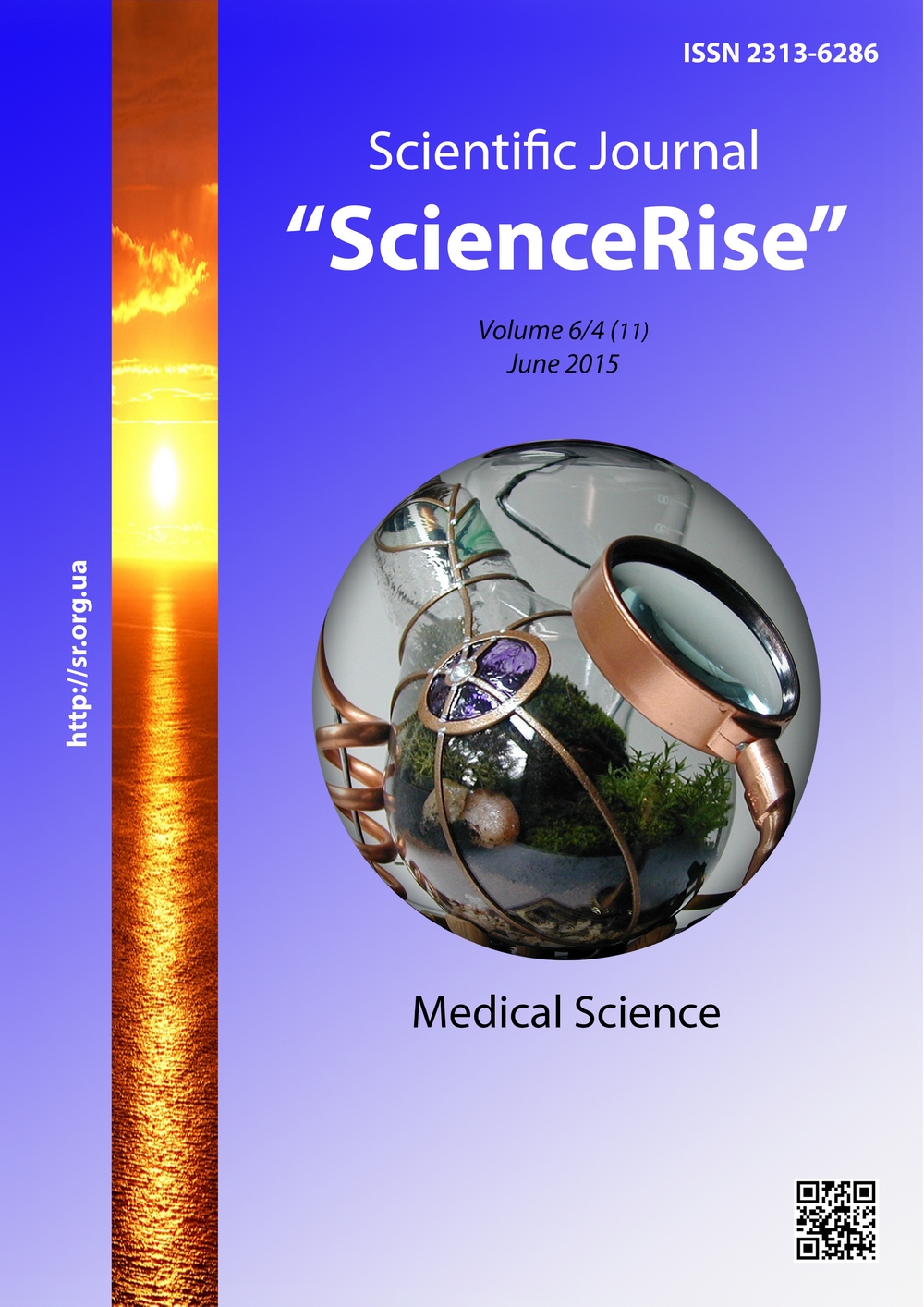Evaluation of anti-stressor protection of the different methods of general anesthesia at an adenotomy in children
DOI:
https://doi.org/10.15587/2313-8416.2015.45317Keywords:
adenotomy, intravenous anesthesia, inhalational anesthesia, stress markers, childrenAbstract
Aim. An evaluation of the level of anti-stressor protection of the different methods of general anesthesia at adenotomy in children by the study of indicators of hemodynamics and the level of “stress markers”.
Materials and methods. Research includes 60 children 6-11 years old who underwent adenotomy. Patients were divided into 3 groups: I group (n=21) – were operated in conditions of intravenous anesthesia on the basis of propofol in combination with fentanyl; II group (n=19) – were operated in conditions of an inhalational anesthesia with sevoflurane in combination with fentanyl and sodium metamizol; III group (n=20) – were operated in conditions of intravenous anesthesia on the basis of sodium thiopental in combination with fentanyl. The differences considered reliable at р<0,0 using t-criterion of Student. Coefficient of correlation was defined according to Pirson.
Results. It was revealed that in all groups at all stages of research the levels of insulin and glycemia didn’t exceed the limits of the laboratory norm. At the stage of traumatic moment of an operation it was marked an increase of the cortisol level in the I group (p>0,05), but this increase was in the limits of laboratory norm, in II and III groups was the more essential tendency to the growth of cortisol level but it wasn’t marked a reliable difference in groups between the stages (p>0,05). At the stage of extubation of trachea in patients of II and III groups it was marked a tendency to decrease of the cortisol level but the next morning after operation there were no reliable intergroup differences of cortisol level. The stable correlations between the “stress markers” and clinical indicators weren’t fixed. BIS-monitoring in children in conditions of general anesthesia with sodium thiopental needs the more precise investigation.
Conclusions. Anesthesia with the use of propofol in combination with fentanyl (2mkg/kg) ensures the most pronounced level of anti-stressor protection at an adenotomy in children
References
Zil'ber, A. P. (1994). Klinicheskaja fiziologija v anesteziologii i reanimatologii [Clinical physiology in anesthesiology and intensive care]. Moscow: Medicina, 113–124.
Reis, F. M., Ribeiro-de-Oliveira, A. Jr., Machado, L., Guerra, R. M., Reis, A. M., Coimbra, C. C. (2008). Izmenenija prolaktina i gljukozy v plazme, inducirovannye hirurgicheskim stressom: edinaja ili dvojstvennaja reakcija? [Plasma prolactin and glucose alterations induced by surgical stress: a single or dual response?] Mini-review (Trans. From English V. Fesenko). Medicina neotlozhnyh sostojanij, 5 (18), 108–114.
Gvak, G. V. (2005). Hirurgicheskij stress i estestvennye stress limitirujushhie sistemy u detej [Surgical stress and natural stress-limiting system in children]. Scientific Research Institute of General Resuscitation Russian Academy of Medical Sciences. Moscow, 46.
Palmieri, T. L., Levine, S., Schonfeld-Warden, N., OʼMara, M. S., Greenhalgh, D. G. (2006). Hypothalamic–Pituitary–Adrenal Axis Response to Sustained Stress after Major Burn Injury in Children. Journal of Burn Care & Research, 27 (5), 742–748. doi: 10.1097/01.bcr.0000238098.43888.07
Yang, L.-Q., Li, J.-J., Chen, S.-Q., Wang, Y.-W. (2012). Effect of Different Depths of Anesthesia on Perioperative Stress Response in Children Undergoing Adenoidectomy and Tonsillectomy. CNS Neuroscience & Therapeutics, 19 (2), 134–135. doi: 10.1111/cns.12038
Taylor, L. K., Auchus, R. J., Baskin, L. S., Miller, W. L. (2013). Cortisol Response to Operative Stress With Anesthesia in Healthy Children. The Journal of Clinical Endocrinology & Metabolism, 98 (9), 3687–3693. doi: 10.1210/jc.2013-2148
Golub, I. E., Sorokina, L. V. (2005). Hirurgicheskij stress i obezbolivanie: monografija [Surgical stress and pain relief: a monograph]. 2-nd edition. Irkutsk: 201.
Golub, I. E. (1998). Zakonomernosti razvitija i puti preduprezhdenija al'terirujushhih jeffektov stressa [Patterns of development and ways to prevent of stress effects]. East Siberian Scientific Center for Human Ecology Siberian Branch of Russian Academy of Medical Sciences. Irkutsk, 42.
Meerson, F. Z. (1981). Adaptacija, stress i profilaktika [Adaptation, stress and prevention]. Moscow: Nauka, 278.
Salvo, I., Silvani, P., Camporesi, A. (2004). Why and when is inhalation anaesthesia better. Anaesthesia, Pain, Intensive Care and Emergency Medicine, Proceedings of the 19th Postgraduate Course in Critical Care Medicine Trieste, Italy, 195–204, doi: 10.1007/88-470-0351-2_19
Chumbley, G. M., Hall, G. M. (1997). Recovery after major surgery: does the anaesthetic make any difference? British Journal of Anaesthesia, 78 (4), 347–349. doi: 10.1093/bja/78.4.347
Rains, P. C., Rampersad, N., De Lima, J., Murrell, D., Kinchington, D., Lee, J. W., Maguire, A. M., Donaghue, K. C. (2009). Cortisol response to general anaesthesia for medical imaging in children. Clinical Endocrinology, 71 (6), 834–839. doi: 10.1111/j.1365-2265.2009.03591.x
Hsu, A. A., von Elten, K., Chan, D., Flynn, T., Walker, K., Barnhill, J. et. al. (2012). Characterization of the Cortisol Stress Response to Sedation and Anesthesia in Children. The Journal of Clinical Endocrinology & Metabolism, 97 (10), E1830–E1835. doi: 10.1210/jc.2012-1499
Panin, L. E. (1983). Biohimicheskie mehanizmy stressa [Biochemical mechanisms of stress]. Novosibirsk: Nauka, 240.
Downloads
Published
Issue
Section
License
Copyright (c) 2015 Михайло Борисович Пушкар, Маріне Акопівна Георгіянц, Оксана Володимирівна Піонтковська

This work is licensed under a Creative Commons Attribution 4.0 International License.
Our journal abides by the Creative Commons CC BY copyright rights and permissions for open access journals.
Authors, who are published in this journal, agree to the following conditions:
1. The authors reserve the right to authorship of the work and pass the first publication right of this work to the journal under the terms of a Creative Commons CC BY, which allows others to freely distribute the published research with the obligatory reference to the authors of the original work and the first publication of the work in this journal.
2. The authors have the right to conclude separate supplement agreements that relate to non-exclusive work distribution in the form in which it has been published by the journal (for example, to upload the work to the online storage of the journal or publish it as part of a monograph), provided that the reference to the first publication of the work in this journal is included.

